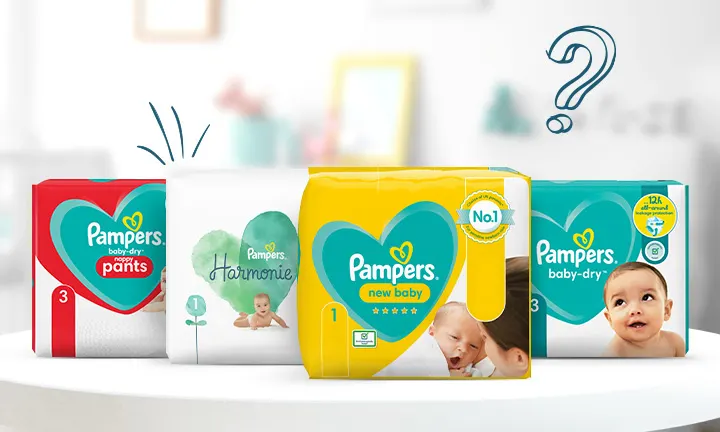Pampers is a brand of disposable diapers and baby care products that was introduced in the United States in 1961 by Procter & Gamble, one of the world’s largest consumer goods companies. The brand was created by Victor Mills, a chemical engineer who worked for Procter & Gamble, after he noticed that his grandson’s cloth diaper was leaky and uncomfortable.
Mills set out to create a better alternative, and after years of research and development, he introduced the first Pampers diaper in 1961. The original Pampers diaper was a simple design made of absorbent paper, with an adjustable adhesive tape to keep it in place. It was an instant hit with parents, who appreciated the convenience and comfort that disposable diapers offered.
Over the years, Pampers has continued to innovate and improve its products, introducing features such as elastic leg cuffs, contoured shapes, and ultra-absorbent materials. The brand has also expanded to include a wide range of baby care products, including wipes, training pants, and diaper rash cream.
Today, Pampers is one of the most well-known and trusted baby care brands in the world, with a presence in over 100 countries. The brand is committed to providing products that help keep babies dry, comfortable, and healthy, and it works closely with pediatricians and other experts to ensure that its products are safe and effective. Pampers has also launched various initiatives to support parents and babies, such as its “Pampers Rewards” program and its “Pampers UNICEF” partnership, which aims to eliminate maternal and neonatal tetanus in developing countries.
History of Pampers
The history of Pampers dates back to the early 1950s, when Victor Mills, a chemical engineer working for Procter & Gamble (P&G), became frustrated with the lack of effectiveness of traditional cloth diapers that were being used to diaper his grandson. Mills believed that there must be a better way to keep babies dry and comfortable, and he set out to develop a disposable diaper that would address the shortcomings of cloth diapers.
Mills spent years experimenting with different materials and designs, and he eventually developed a prototype of a disposable diaper made of absorbent paper. In 1956, P&G applied for a patent for the diaper, which was granted in 1961. The first Pampers diaper was introduced in the United States in 1961, and it quickly became a popular alternative to cloth diapers, which were the only option available at the time.
The original Pampers diaper was a simple design made of absorbent paper with an adjustable adhesive tape to keep it in place. It was a significant improvement over cloth diapers, which were bulky, leaky, and time-consuming to clean. Pampers were more convenient, more hygienic, and allowed parents to spend less time on diapering and more time with their babies.
As the popularity of disposable diapers grew, Pampers continued to innovate and improve its products. In 1971, Pampers introduced its first stretchy diaper with elastic leg cuffs, which provided a better fit and reduced the risk of leaks. In 1986, Pampers introduced its first ultra-absorbent diaper, which could hold up to ten times its weight in liquid.
Differential Proposition of Pampers
The differential proposition of Pampers is its ability to provide high-quality disposable diapers that keep babies dry, comfortable, and healthy. Pampers differentiates itself from other diaper brands by offering a range of features and benefits that are designed to meet the unique needs of babies and their parents. Some of the key differential propositions of Pampers include:
Superior absorbency: Pampers diapers are made with ultra-absorbent materials that can hold up to 12 hours of wetness, keeping babies dry and comfortable for longer periods.
Softness and comfort: Pampers diapers are designed with soft, breathable materials that help prevent diaper rash and keep babies comfortable.
Customized fit: Pampers diapers come in a range of sizes and styles, including newborn, baby, and toddler sizes, and they are designed to fit snugly and comfortably on babies of all sizes.
Leakage protection: Pampers diapers feature leak-proof barriers and elastic leg cuffs that help prevent leaks and blowouts, giving parents peace of mind.
Trusted brand: Pampers is a well-known and trusted brand that has been providing high-quality baby care products for over 60 years. The brand works closely with pediatricians and other experts to ensure that its products are safe and effective.
Overall, Pampers’ differential proposition is its ability to provide parents with high-quality, reliable, and convenient baby care products that help keep babies dry, comfortable, and healthy.
Target Audience and Market Segmentation of Pampers
Pampers primarily targets parents with young children, specifically those with infants and toddlers. The brand segments its market by age, offering a range of products for newborns, babies, and toddlers. Additionally, Pampers targets parents who value convenience and reliability, as well as those who are willing to pay a premium for high-quality baby care products.
Marketing Strategies of Pampers
Pampers, one of the leading brands in the baby care industry, has implemented various marketing strategies to maintain its position in the market and attract new customers. In this section, we will discuss some of the key marketing strategies that Pampers has used to promote its brand and products.
Advertising campaigns:
Pampers has used various advertising campaigns to promote its brand and products. The brand’s advertising campaigns typically focus on the emotional connection between parents and babies, using heartwarming images and videos to create an emotional connection with its target audience. Pampers’ advertisements also highlight the unique features of its products, such as superior absorbency, comfort, and fit. The brand has also used celebrity endorsements in its advertising campaigns, featuring well-known parents and their babies.
For example, in 2018, Pampers collaborated with John Legend for its “Love the Change” campaign, which aimed to celebrate the special bond between fathers and babies.
Social media presence:
Pampers has an active presence on social media platforms like Facebook, Twitter, and Instagram. The brand uses social media to engage with parents and provide them with useful information and support. Pampers’ social media accounts feature heartwarming images and videos of babies and parents, along with helpful tips and advice on parenting and baby care. The brand also encourages user-generated content, encouraging parents to share their experiences and photos of their babies.
For example, in 2020, Pampers launched its #ShareTheLove campaign, encouraging parents to share photos and stories of their babies to spread love and positivity during the pandemic.
Content marketing:
Pampers has implemented content marketing strategies to provide valuable information and support to parents. The brand’s website features a range of content, including informative articles, expert advice, and product reviews. Pampers’ content marketing strategy aims to establish the brand as a trusted source of information and support for new and expectant parents.
For example, the brand’s website offers articles on topics like diaper rash, baby development, and parenting tips.
Product differentiation:
Pampers differentiates its products from competitors by offering superior quality, comfort, and convenience. The brand’s diapers are designed with ultra-absorbent materials that can hold up to 12 hours of wetness, and they feature soft, breathable materials that help prevent diaper rash and keep babies comfortable.
Pampers also offers a range of sizes and styles to fit babies of all ages and sizes, and its diapers are designed to fit snugly and comfortably. Additionally, Pampers offers features like wetness indicators, which make it easy for parents to know when their baby needs a diaper change.
Partnerships and collaborations:
Pampers has partnered with hospitals, healthcare providers, and other brands to promote its products and offer support to new parents. The brand’s partnerships with hospitals and healthcare providers aim to provide information and support to new parents, while its collaborations with other brands offer promotional opportunities and exposure to new audiences.
For example, in 2019, Pampers partnered with the American Academy of Pediatrics to launch its “Pampers for Preemies” campaign, which aimed to provide support and resources to parents of premature babies. Additionally, Pampers has collaborated with other brands like Walmart and Target to offer exclusive promotions and discounts to customers.
Brand Campaigns of Pampers
Pampers has a long history of creating memorable and effective brand campaigns. Here are some of the most notable:
“Pampers Love, Sleep & Play” (2012-2016): This campaign featured heartwarming videos and photos of babies and parents bonding over sleep, playtime, and other everyday moments. The campaign aimed to establish an emotional connection with parents and highlight the importance of quality time spent with babies. The “Love, Sleep & Play” campaign included TV commercials, online videos, and social media content.
“Better for Baby” (2015-2018): In this campaign, Pampers emphasized its commitment to providing the best possible products and care for babies. The campaign featured testimonials from real parents about their experiences with Pampers products, along with information about the brand’s research and development process. The “Better for Baby” campaign included TV commercials, online videos, and print ads.
“Pampers #ThankYouMidwife” (2017): This campaign aimed to celebrate and show appreciation for midwives, who play a crucial role in helping new mothers and babies. Pampers partnered with the Royal College of Midwives in the UK to create a short film featuring midwives and the mothers they helped. The brand also donated £1 for every pack of Pampers sold in the UK during the campaign to support midwifery training and education.
“Pampers Preemie Protection” (2019): This campaign aimed to raise awareness of the challenges faced by premature babies and their families. Pampers partnered with the American Academy of Pediatrics to launch its “Pampers for Preemies” program, which provided support and resources to parents of premature babies. The campaign included TV commercials and social media content.
“Share the Love” (2020-2021): In response to the COVID-19 pandemic, Pampers launched the “Share the Love” campaign to spread positivity and connection among families. The campaign encouraged parents to share photos and stories of their babies using the hashtag #ShareTheLove. Pampers also donated $2 million to various charities supporting families during the pandemic. The campaign included TV commercials, social media content, and an online hub featuring parenting resources and activities.
“Pampers #ItTakes2″ Campaign (2021) : The campaign was launched in 2021 and is focused on highlighting the important role that fathers play in the care of their babies.
The campaign centers around a short film that features a diverse group of fathers sharing their experiences of parenting and the special bond they have with their babies. The film shows the fathers performing various tasks such as feeding, changing diapers, and playing with their babies, highlighting that taking care of a baby is a team effort that requires both parents to be involved.
The hashtag #ItTakes2 is used throughout the campaign to emphasize the importance of both parents working together to care for their baby. The campaign aims to break down stereotypes around parenting and encourage fathers to take an active role in their children’s lives, including the day-to-day care.
Overall, the Pampers #ItTakes2 campaign is a powerful reminder of the crucial role that fathers play in the lives of their children and the importance of sharing the responsibilities of parenting equally between both parents.
Overall, Pampers’ brand campaigns have been successful in creating an emotional connection with parents and establishing the brand as a trusted and caring partner in baby care. The brand’s campaigns often focus on the everyday moments of parenthood and the importance of quality time spent with babies, while also highlighting the superior quality and performance of Pampers products.
Also Read: Exploring the Brand Architecture of HUL
Segmentation, Targeting and Positioning (STP) of Pampers
STP analysis is a marketing tool used to understand the segmentation, targeting, and positioning of a brand in the market. Here is a detailed explanation of the STP analysis of Pampers:
Segmentation: The baby care market is divided into several segments based on various factors such as age, gender, income, and lifestyle. Pampers, being a leading brand in the baby care industry, segments its target audience based on the following factors:
- Age: Pampers targets parents of infants and toddlers, ranging from newborns up to three years of age.
- Income: Pampers caters to both low-income and high-income families, offering a range of products at different price points.
- Geographic location: Pampers targets parents globally, but their marketing strategies may vary depending on the cultural and economic factors of each region.
Targeting: Pampers’ target market is parents who are looking for quality baby care products that offer comfort, protection, and convenience. Pampers focuses on the following target segments:
- First-time parents: Pampers targets new parents who are looking for reliable and high-quality products to care for their newborn.
- Working parents: Pampers offers products that are convenient and time-saving, making it easy for busy parents to manage their baby’s care.
- Health-conscious parents: Pampers offers products that are hypoallergenic and free from harmful chemicals, catering to parents who are concerned about their baby’s health.
Positioning: Pampers positions itself as a brand that offers premium quality baby care products that provide comfort, protection, and convenience. Pampers’ positioning strategy is based on the following factors:
- Quality: Pampers positions itself as a high-quality brand, offering products that are designed to provide maximum comfort and protection to babies.
- Convenience: Pampers offers a range of products that are easy to use and save time, catering to busy parents.
- Innovation: Pampers positions itself as an innovative brand that is constantly developing new and improved products to meet the changing needs of parents.
In summary, Pampers segments its target audience based on age, income, and geographic location. The brand targets parents who are looking for quality baby care products that offer comfort, protection, and convenience. Pampers positions itself as a high-quality brand that offers innovative and convenient products to meet the needs of parents.
To read more content like this, subscribe to our newsletter



